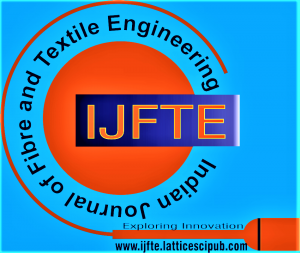![]()
Valorisation of Wool Waste and Chicken Feathers for Medical Textile Applications
Sumit Panhalkar1, Shriyasha Tari2, Ashok Athalye3
1Mr. Sumit Panhalkar, Department of Fibres and Textile Processing Technology, Institute of Chemical Technology, Nathalal Parekh Marg, Matunga, Mumbai (Maharashtra), India.
2Shriyasha Tari, Department of Fibres and Textile Processing Technology, Institute of Chemical Technology, Nathalal Parekh Marg, Matunga, Mumbai (Maharashtra), India.
3Dr. Ashok Athalye, Department of Fibres and Textile Processing Technology, Institute of Chemical Technology, Nathalal Parekh Marg, Matunga, Mumbai (Maharashtra), India.
Manuscript received on 29 April 2024 | Revised Manuscript received on 08 May 2024 | Manuscript Accepted on 15 May 2024 | Manuscript published on 30 May 2024 | PP: 1-9 | Volume-4 Issue-1, May 2024 | Retrieval Number: 100.1/ijfte.A240904010524 | DOI: 10.54105/ijfte.A2409.04010524
Open Access | Editorial and Publishing Policies | Cite | Zenodo | OJS | Indexing and Abstracting
© The Authors. Published by Lattice Science Publication (LSP). This is an open-access article under the CC-BY-NC-ND license (http://creativecommons.org/licenses/by-nc-nd/4.0/)
Abstract: Waste valorisation is the key to waste minimization. Chicken feathers and wool fabric waste are rich in protein content. Keratin forms a major part of these two materials. However, these keratin rich material are often discarded and finally end up as waste in landfills or incinerated. This research aims to upcycle woolen waste and chicken feathers by selectively extracting keratin from them. This study reports the development of a wound-healing nanofibre patch derived from non-conventional keratin sources like waste wool and chicken feathers. It aims to repurpose these abundant and underutilised materials, taking advantage of their high crude protein content. A three-step process for developing wound healing material is reported: cleaning waste wool and chicken feathers and extracting keratin to make electrospun nanofibre patch. The electrospun keratin patch is incorporated with honey, a natural antiseptic agent for producing desired wound healing properties. The extraction of keratin is initially tested qualitatively using Biuret test. The Scanning Electron Microscopy (SEM) images confirm the successful electrospinning of keratin nanofibres, demonstrating a well-defined and uniform fibrous surface morphology. The FT-IR spectrum confirms the presence of functional groups associated with keratin. Furthermore, the antimicrobial study shows promising results, indicating that the protein-based nanofiber patch supports cell growth activity. These findings suggest that the keratin-based nanofiber patch derived from waste wool and chicken feathers has the potential to facilitate the regeneration of damaged tissue and can aid in the wound-healing process. The findings of these study confirms possible extraction of keratin from wool waste and chicken feathers and its application in medical textile applications.
Keywords: Antiseptic, Electrospinning, Keratin, Protein-extraction, Wound healing
Scope of the Article: Fabrics
